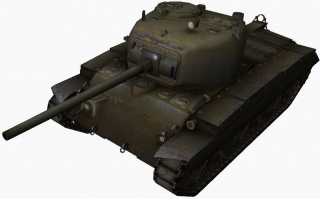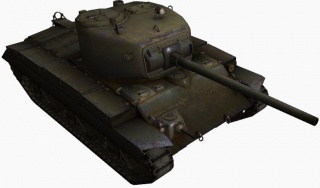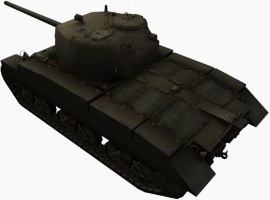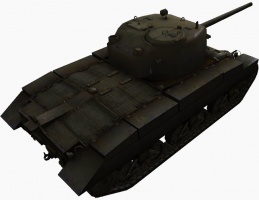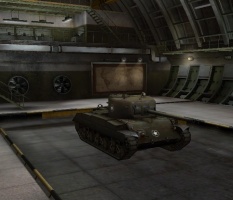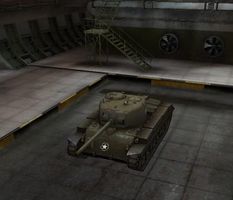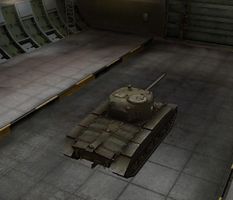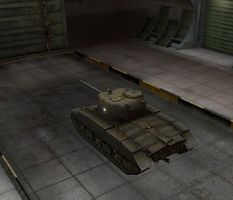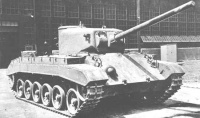T20
| |
This article requires additional modification. The design and/or content of this article do not conform to wiki standards.
|
T20
Mouse over "
[Client Values; Actual values in
| 1,340,000 |
| 1000300 HP Hit Points |
| 28.89/3016.78/34 t Weight Limit |
- Commander
- Gunner
- Driver
- Radio Operator
- Loader
| 520560 hp Engine Power |
| 56/20 km/h Speed Limit |
| 3737 deg/s Traverse |
| 1833.37 hp/t Power/Wt Ratio |
| NoNo Pivot |
| // mm Hull Armor |
| 88.9/63.5/63.588.9/63.5/63.5 mm Turret Armor |
AP/APCR/HE
AP/APCR/HE Shells |
96/2800/68
255/4400/255 Shell Cost |
| 115/115/185240/240/320 HP Damage |
| 128/177/38160/243/45 mm Penetration |
|
14.29 r/m ▲
6.38 r/m Standard Gun ▲ Rate of Fire Standard Gun |
|
1643.35 ▲
Standard Gun
▼
Standard Gun
▲
1531.2 Standard Gun ▲
Standard Gun
▼
Standard Gun
▲ Damage Per Minute Standard Gun |
|
0.43 m ▲
0.38 m With 50% Crew: 0.533 m ▲ Accuracy With 50% Crew: 0.471 m |
| 2.3 s 2.3 s Aim time |
| 4442 deg/s Turret Traverse |
| 360° Gun Arc |
| -10°/+25°-10°/+25° Elevation Arc |
| 8548 rounds Ammo Capacity |
| 2020 % Chance of Fire |
| 370 m 390 m View Range |
| 395 m 615 m Signal Range |
Additional Statistics
(Top Configuration)
Camouflage
- Stationary: 16.3%
- When Moving: 12.6%
- When Firing: 4.3%
Terrain Resistance
- On Hard Ground: 0.96
- On Medium Ground: 1.06
- On Soft Ground: 1.63
Dispersion Change Values
- Turret Contribution
- Rotation: 0.12
- Shot Recoil: 3.36
- Suspension Contribution
- Acceleration: 0.19
- Turning: 0.19
With 100% Crew
VII
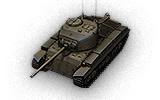
1340000
The T20 is an American tier 7 medium tank.
The first in a series of 1942–1943 U.S. medium tank designs intended as replacements for the M4 Sherman. The first prototype was produced in May 1943, and trials went on until 1944. The vehicle was not approved for mass production, but subsequent prototypes, the T22 and T23, were created on the basis of this development. They, in turn, served as precursors of the T25 and T26. Eventually, the M26 Pershing emerged on their basis and was adopted for service.
Much like the M4A3E8 Sherman, the T20 lacks significant armor. Able to sneak around the battlefield the T20 is an excellent support tank and able to switch between engagements in very short time. Its thin armor is a serious weakness and caution must be taken to avoid enemy fire whenever possible. Pick different strategies to match different opponents: flank heavy tanks, ambush and brawl mediums, track and destroy lights. Passive scouting is also viable when other scouts are not available.
The T20 leads to the T69, and the M26 Pershing.
Modules / Available Equipment and Consumables
Modules
| Tier | Engine | Engine Power (hp) |
Chance of Fire on Impact (%) |
Weight (kg) |
Price (
| |
|---|---|---|---|---|---|---|
| VII | Ford GAA | 520 | 20 | 569 | 36000 | |
| VII | Ford GAN | 560 | 20 | 569 | 37200 |
| Tier | Suspension | Load Limit (т) |
Traverse Speed (gr/sec) |
Rmin | Weight (kg) |
Price (
| |
|---|---|---|---|---|---|---|---|
| VI | HVSS T48 | 30 | 37 | B/2 | 5400 | 11900 | |
| VII | HVSS T51 | 34 | 37 | B/2 | 5400 | 17900 |
Compatible Equipment
Compatible Consumables
Player Opinion
Pros and Cons
Pros:
- Good alpha damage and above average penetration (especially with APCR), without suffering from poor gun handling or aim time
- Good speed allows the T20 to charge at distracted enemies, unload a shell and evade retaliation
- Excellent gun depression
- Great view range for its tier
- Low profile gives it very good concealment value
Cons:
- Almost nonexistent armor
- Ammo rack is very fragile
- Next-to-worst damage-per-minute output for Tier VII mediums
- Significant agility downgrade from M4A3E8, although really good speed and acceleration
- Shell velocity somewhat slow
Performance
The T20 is very different from the M4A3E8 Sherman which preceded it. They are both generally mobile, with good gun depression and have no real armor to speak of. However the three main differences of the T20 are its inferior hull traverse, especially at speed; greater speed limits allowing for faster relocation; lower silhouette; high-alpha, high-penetrating, low rate-of-fire gun. This makes the T20's play style markedly different from the Easy Eight.
The hull traverse is noticeably sluggish at 37 degrees per second, which doesn't compare favorably with the 40 deg./sec. on the M4A3E8. This is increasingly noticeable when the T20 is turning at full-speed. It tends to lose speed far more rapidly than an Easy Eight in a turn, making it less suited to running circles around slow heavy tanks. However it's still very capable of doing so if needed -- the M4A3E8 is just better at it. It should be noted that the turret traverse on the T20 is better, at 44 deg./sec., which compares favorably to the 39 deg./sec. on the Easy Eight.
A striking difference between the two vehicles is the fact the T20 has a much smaller profile than the M4A3E8. Combined with its 10 degrees of gun depression it can assume hull-down positions reliably at range, and is a significantly smaller target -- an important factor for a medium that relies on avoiding shells. However it lacks a significant gun mantlet, and this reduces its hull-down trading performance considerably compared to the Easy Eight for its tier.
However, the biggest difference between the T20 and the M4A3E8 is the fact the T20 can receive the 90mm M3 main gun, which boasts vastly superior alpha damage and 32mm of extra penetration, but a very slow rate of fire. The premium HVAP ammunition allows it to punch through the fronts of IS-3 tanks with ease. The only real downside is that the reload is slow compared to other American tanks armed with the 90mm M3 and its longer-barreled derivatives. Making your shots count is vital, unlike the Easy Eight where the high rate of fire makes up for misses. Therefore the T20 is best played with a peek-a-boom style where you pull straight out, fire, and duck behind cover after shooting.
The T20 can utilize terrain very well with its high gun depression; good fire control and alpha damage means it only needs minimal exposure. Its mobility should be used to avoid enemy fire and flank them. It can circle slow heavies as well, although the M4A3E8 may be better in this role as it traverses faster. Late in the battle you can rely on your top speed to hunt artillery or reset the cap.
Also, be aware of the excellent view range and camouflage values on this tank -- you can easily see many tanks before they ever catch wind of you as long as you remain hidden.
Boasting 390m of view range, equivalent to the best of Tier VI light tanks, the T20 can be an excellent passive scouter if need be, and the concealment values are great too, it having the same size as the T21, a Tier VI American light tank. Use this advantage to gain sight lines over the map and deal spotting damage as well as shots from your excellent gun.
Repair skills are highly recommended and at least 2 crew should be fully trained in this. A tracked T20 will receive heavy fire and shells from artillery, so Repair skills are essential for survival. If playing as a mid-range sniper with the above-average accurate 90mm some Concealment skills will help greatly, allowing you to know when to relocate and hide better. If using the T20 as a flanker, Snap Shot and Smooth Ride/Off-Road Driving will reduce accuracy penalties and increase mobility even more. Once all off these skills are acquired, Brother in Arms is recommended which will increase every desirable stat on your tank even more.
The T20, like many American vehicles, is a versatile machine which can be used as a sniper or a flanker. Regardless of setup, a Gun Rammer is a necessity, since the T20 has the slowest reload time of all American tanks with the 90mm M3 and its derivatives, excluding the time it takes a T69's autoloader to reload. However the other two slots are up to your own choosing. Flankers can opt for a Vertical Stabilizer and Coated Optics for optimal accuracy on the move. Snipers can go for Enhanced Gun Laying Drive, Camouflage Net, and Binocular Telescope or Coated Optics. Alternatively Vents are viable option for an overall boost to crew abilities.
The T20's crew setup -- Commander, Gunner, Driver, Radio Operator, Loader -- matches a plethora of premium American mediums: the Eagle 7, Fury, M46 FL, M46 KR, M4 Improved, M4A2E4, Ram II, T23E3, T25 Pilot 1, T26E4 SuperPershing, and the Thunderbolt -- you can more or less use one crew for all these tanks; the only thing to consider is what their crew skills are compared to how you drive them.
Overall the T20 is a great asset and threat when played correctly, and should not be underestimated. Considered by many as the best Tier VII medium for good reason, it possesses many of the strengths one desires from a medium tank and can be a pleasure to play.
Early Research
- The 76mm Gun M1A2 carries over from both the M4A3E8 Sherman and the M4A3E2 Sherman Jumbo. Install the M1A2 and the familiar SCR 506 radio immediately
- First research the Ford GAN engine
- Then research the upgraded suspension
- Now research the second turret, and then the 90mm gun. (Even if you don't intend to use the 90mm gun it is vitally important to unlock it now, because you will need it on the Pershing)
Suggested Equipment
External Reviews and Opinions
Gallery
Historical Info
Much like other armies at the time, the U.S. Army envisioned two main roles for tanks: infantry support and breakthrough exploitation. From 1942 until the end of World War II, both roles were covered in the main by the M4 Sherman, which was better suited for the latter "cavalry" role. The infantry would have preferred a better protected and better armed vehicle, even at a price of less mobility. In late 1942, U.S. Army Ordnance started to work on an "infantry-oriented" design which was supposed to be more versatile than the British infantry tanks. During the next two years, various prototypes were built under the designations T20, T22, T23, T25, and T26. Starting with the T20, the Ordnance Department initially developed three series of improved medium tank prototypes, the T20, T22, and T23. The main differences between the T20, T22, and T23 lay in the choice of transmission. The T20 used a torque converter fluid drive, the T22 a 5-speed mechanical drive similar to the M4 drive, and the T23 used an electric drive. Additionally, the T20 had an early version of the HVSS suspension later employed on the M4 Sherman, whereas the T20E3 had torsion-bar suspension. All moved the transmission to the rear of the vehicle, eliminating the need for a drive-shaft running the length of the vehicle. The drive-shaft used in the M3 & M4 vehicles forced the turret to be mounted higher, thus increasing the vehicle height.
However, the initial success of the M4 led the Army Ground Forces command to believe that there was no urgent need for a new tank. Even with the appearance of the heavy Tiger and medium Panther tanks, the AGF did not alter its position, believing both tanks would be fielded in relatively small numbers. AGF was correct about the Tiger, a specialized heavy tank that was never encountered in large numbers. The Panther, first encountered in small numbers at Anzio, however, was built in very large numbers and formed half the German tank strength in Normandy. Also, according to the Army doctrine of the time, tanks were not supposed to engage other tanks; this was the remit of tank destroyers, more mobile armored vehicles with powerful guns, such as the M10 Wolverine. As a result, the development of the new tank was slow. When the Allies invaded western Europe during Operation Overlord in June 1944, the M4 still formed the bulk of American tank units. It quickly became clear that the tank destroyer doctrine failed in the field and that the up-gunned Sherman was unable to engage the Panther on equal terms. Efforts were made to speed up development, but the tank, by now called the T26 and dubbed Pershing, reached the battlefield only in February 1945 and saw very little action in WWII.
Historical Accuracy Errata
The 90 mm gun was only mounted on the T25 which had a Pershing turret and a slightly enlarged hull. Its configuration on the T20 is fake.
- 75 mm M3 autoloader and 3-inch M7 gun are missing. Both were planned but never constructed. Along with the 76 mm M1, these three guns were only considered for the T20 series. The 105 mm howitzer configuration is fake.
- Its engine is considerably more powerful than in reality, with 560 hp compared to the historical 470.
- Torsion bar suspension is missing. This model, armed with the 76 mm M1, was known as the T20E3.
















